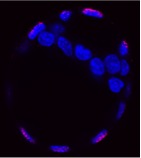Mohamed Ashry
Mohamed studies the role of TFAP2C in establishing the trophoblast lineage gene expression program by forming a regulatory complex with TEAD4, YAP1, and other key proteins.
 Research
Research
Transcription factor AP2γ (TFAP2C) is a key regulator of mammalian trophoblast lineage formation required for cell polarization, position-dependent HIPPO signaling, and Cdx2 expression. Mohamed studies the role of TFAP2C in establishing the trophoblast lineage gene expression program by forming a regulatory complex with TEAD4, YAP1, and other key proteins. He is using loss of function and gain of function methods, co-immunoprecipitation, ChIP, and gene expression analysis in preimplantation embryos and Tfap2c-inducible ES cells to assay for: a) physical and functional interactions between TFAP2C, TEAD4, YAP1, and other co-regulators; b) effects on chromatin accessibility, and c) transcriptional regulation of trophoblast specific genes.
Recent Publications
- Mohamed Ashry, Sandeep Rajput, Joseph Folger, Chunyan Yang, Jason Knott, and George W. Smith (2020): Follistatin treatment modifies the DNA methylation pattern of the CDX2 gene in bovine embryos. Molecular Reproduction and Development. 2020: 1–11. https://doi-org.proxy2.cl.msu.edu/10.1002/mrd.23409
- Challis Karasek, Mohamed Ashry*, Chad S. Driscoll, and Jason G. Knott (2020): A tale of two cell-fates: Role of the hippo signaling pathway and transcription factors in early lineage formation in mouse preimplantation embryos. Molecular Human Reproduction, 26 (9): 653–664 https://doi:10.1093/molehr/gaaa052 . (*co-first author)
 Outreach Project
Outreach Project
Mohamed will be volunteering in the university events that promote STEM among children and young adults including MSU Science Festival and Science Olympiad. The 2021 MSU science festival will be virtual. Mohamed will provide an online demonstration for the in vitro embryo production process with real pictures for sperms, oocytes, and different stages of preimplantation embryos.



 Print
Print Email
Email